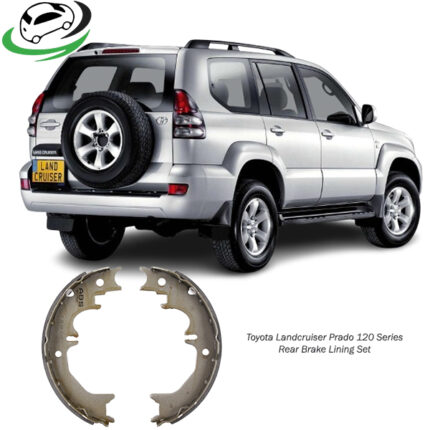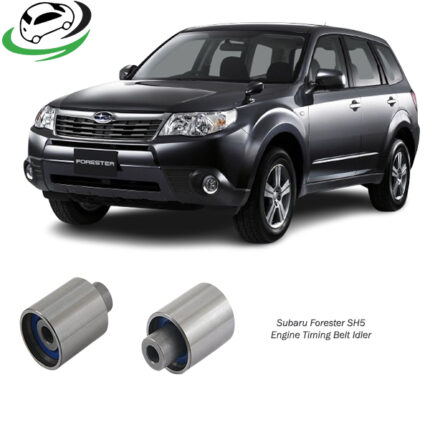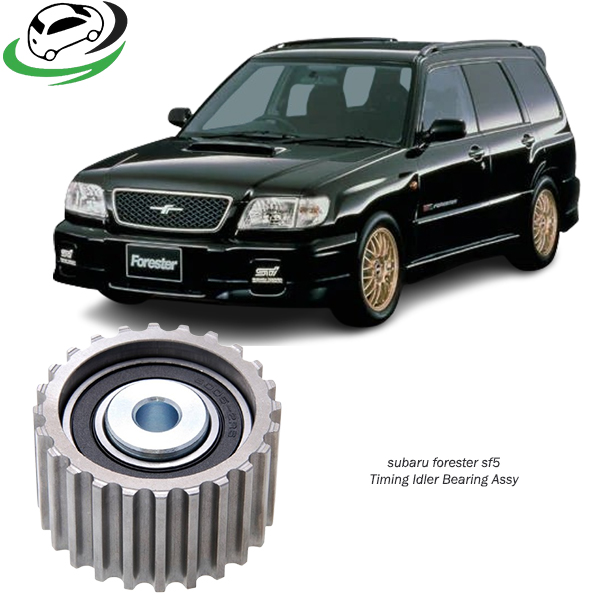-8%
Get Subaru Forester SF5 Timing Idler Bearing Assy 13085AA080
The timing idler bearing assembly is a crucial component in many engines with timing belt systems. Often overlooked, the idler bearing plays an essential role in maintaining the belt’s tension and alignment, ensuring the precise timing necessary for optimal engine performance. Let’s explore the details of the timing idler bearing assembly, including its function, types, benefits, signs of wear, and maintenance tips.
1. Purpose and Function of the Timing Idler Bearing Assembly
The timing idler bearing assembly serves multiple functions within an engine:
- Maintains Tension: The idler bearing keeps the timing belt tight, preventing slack that could lead to improper timing.
- Guides the Belt: It ensures the timing belt follows a set path, keeping it in alignment with the camshaft and crankshaft pulleys. This alignment is crucial for the engine’s timing and overall function.
- Reduces Vibration: The bearing within the idler assembly helps reduce vibrations and noise by absorbing the stress exerted on the timing belt.
- Enhances Belt Life: By ensuring the belt maintains the correct path and tension, the idler bearing helps extend the belt’s lifespan, reducing wear and tear.
2. Components of the Timing Idler Bearing Assembly
A timing idler bearing assembly comprises the following key parts:
- Bearing: The inner part that provides smooth rotation. High-quality bearings typically have a metal ball or roller bearing construction to handle the stress of the timing belt.
- Pulley: The circular component that makes direct contact with the timing belt. This pulley is connected to the bearing and rotates to guide the belt.
- Mounting Bracket: The bracket or bolt that attaches the idler bearing assembly to the engine block, securing its position.
3. Types of Timing Idler Bearings
Timing idler bearings can vary based on their design and materials:
- Ball Bearings: The most common type, ball bearings use a series of metal balls to reduce friction between the pulley and its mounting. They’re durable, but may wear over time if exposed to excessive heat or contaminants.
- Roller Bearings: Some idlers use cylindrical rollers instead of balls. Roller bearings can handle higher loads and are often found in heavy-duty applications.
- Sealed Bearings: High-quality timing idler bearings are sealed to protect against dust, dirt, and moisture, extending their lifespan and improving reliability.
4. Benefits of a Well-Functioning Timing Idler Bearing
A properly maintained timing idler bearing assembly offers numerous advantages:
- Improved Timing Accuracy: The idler bearing ensures precise belt alignment, maintaining the exact timing needed for optimal engine performance.
- Reduced Noise and Vibration: A smoothly functioning bearing reduces noise and dampens vibrations within the timing belt system, contributing to a quieter engine.
- Extended Belt and Engine Life: A well-functioning idler bearing helps reduce stress on the timing belt, prolonging its life and decreasing the likelihood of premature wear on engine components.
- Reduced Risk of Belt Slippage: Proper tension and alignment reduce the risk of timing belt slippage, which can lead to serious engine damage if the camshaft and crankshaft fall out of sync.
5. Signs of a Failing Timing Idler Bearing
Recognizing signs of wear in the timing idler bearing can help prevent more extensive engine issues:
- Unusual Noises: A failing idler bearing may produce squealing or grinding sounds, especially when the engine is idling. This noise usually indicates that the bearing has worn out or lacks proper lubrication.
- Belt Misalignment: If the timing belt appears misaligned or shows uneven wear, it could be a sign that the idler bearing is malfunctioning, causing the belt to deviate from its intended path.
- Increased Vibration: Excessive vibration in the engine bay, particularly from the timing area, may indicate a problem with the idler bearing, which could cause the belt to vibrate.
- Loss of Engine Timing: Severe idler bearing failure can lead to belt slack, causing engine timing to become erratic. This can lead to a noticeable drop in engine performance and even potential engine damage.
6. Maintenance Tips for Timing Idler Bearings
Regular maintenance can help extend the lifespan of a timing idler bearing:
- Inspect the Timing Belt System Regularly: During routine inspections, check the timing belt and all associated components, including the idler bearing. Look for any signs of wear, such as cracks or noise, and address them promptly.
- Replace as Part of Timing Belt Service: Most manufacturers recommend replacing the timing idler bearing when replacing the timing belt, usually every 60,000 to 100,000 miles. This is because the bearing undergoes similar wear as the belt and is best replaced at the same time to prevent future issues.
- Choose Quality Replacement Parts: Opting for high-quality, OEM-spec idler bearings ensures a better fit and more reliable performance, which can enhance the timing system’s durability.
- Follow Manufacturer Guidelines: Always adhere to the manufacturer’s service recommendations. Using parts that meet or exceed OEM specifications can extend the life of the timing system and improve engine reliability.
7. Replacement Process for the Timing Idler Bearing Assembly
Replacing the timing idler bearing assembly requires mechanical knowledge and involves several key steps:
- Prepare the Vehicle: Start by disconnecting the battery and lifting the vehicle if necessary. Ensure the engine is cool before starting any work.
- Access the Timing System: Remove components such as the engine covers, belts, and pulleys as needed to access the timing belt.
- Inspect Components: Examine the timing belt, tensioner, and idler bearing for signs of wear. If the idler bearing shows signs of damage, it should be replaced along with the belt.
- Remove the Old Idler Bearing: Loosen the bolts securing the idler bearing to the engine block and carefully remove it.
- Install the New Idler Bearing: Attach the new idler bearing assembly, ensuring it is secured in place according to the manufacturer’s torque specifications.
- Reassemble: Once the new bearing is in place, reattach the timing belt and other components, ensuring the belt is aligned and tensioned properly.
- Test the Engine: After reassembly, start the engine to check for unusual noises or vibrations and confirm the timing system is functioning smoothly.
8. Choosing the Right Timing Idler Bearing Assembly
When selecting a timing idler bearing assembly, several factors should be considered:
- OEM vs. Aftermarket: OEM parts offer reliability and compatibility, but high-quality aftermarket options can also perform well and may be more affordable.
- Material and Design: Durable materials and sealed bearing designs can provide better performance and longevity.
- Compatibility: Ensure the idler bearing assembly is compatible with your vehicle’s make and model for a proper fit and optimal performance.
9. Conclusion
The timing idler bearing assembly may be a small component, but it has a significant impact on engine performance. It helps maintain the timing belt’s alignment, reducing wear, vibration, and the risk of timing belt failure. Proper maintenance and timely replacement of the idler bearing can prevent costly repairs and ensure the smooth operation of the timing system, ultimately extending the life of the engine. Recognizing signs of wear and following manufacturer guidelines for replacement intervals will help drivers keep their engines running efficiently and reliably.
Follow us on Facebook for more parts.




Reviews
Clear filtersThere are no reviews yet.